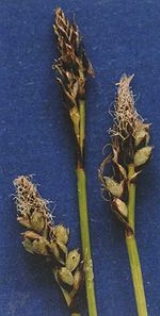
Carex concinnoides
Encyclopedia
Carex concinnoides is a species of sedge
known by the common name northwestern sedge. It is native to western North America from British Columbia
to California
, where it can be found in moist or dry habitat, often in woodland and forested slopes, on silt
y and clay soils. This sedge produces loose clumps of stems up to about 35 centimeters in maximum height from long rhizome
s. The leaves are thick but narrow, sickle-shaped, and pale green in color. Inflorescence
s occur at the stem tips, and some pistillate
inflorescences grow from nodes along the stem. The spikelets have purplish bract
s. The pistillate flowers have four stigmas on each pistil, an identifying characteristic. The fruit is coated in a sac called a perigynium, which is white to light brown in color, purple-tipped, and covered in hairs.
Carex
Carex is a genus of plants in the family Cyperaceae, commonly known as sedges. Other members of the Cyperaceae family are also called sedges, however those of genus Carex may be called "true" sedges, and it is the most species-rich genus in the family. The study of Carex is known as...
known by the common name northwestern sedge. It is native to western North America from British Columbia
British Columbia
British Columbia is the westernmost of Canada's provinces and is known for its natural beauty, as reflected in its Latin motto, Splendor sine occasu . Its name was chosen by Queen Victoria in 1858...
to California
California
California is a state located on the West Coast of the United States. It is by far the most populous U.S. state, and the third-largest by land area...
, where it can be found in moist or dry habitat, often in woodland and forested slopes, on silt
Silt
Silt is granular material of a size somewhere between sand and clay whose mineral origin is quartz and feldspar. Silt may occur as a soil or as suspended sediment in a surface water body...
y and clay soils. This sedge produces loose clumps of stems up to about 35 centimeters in maximum height from long rhizome
Rhizome
In botany and dendrology, a rhizome is a characteristically horizontal stem of a plant that is usually found underground, often sending out roots and shoots from its nodes...
s. The leaves are thick but narrow, sickle-shaped, and pale green in color. Inflorescence
Inflorescence
An inflorescence is a group or cluster of flowers arranged on a stem that is composed of a main branch or a complicated arrangement of branches. Strictly, it is the part of the shoot of seed plants where flowers are formed and which is accordingly modified...
s occur at the stem tips, and some pistillate
Gynoecium
Gynoecium is most commonly used as a collective term for all carpels in a flower. A carpel is the ovule and seed producing reproductive organ in flowering plants. Carpels are derived from ovule-bearing leaves which evolved to form a closed structure containing the ovules...
inflorescences grow from nodes along the stem. The spikelets have purplish bract
Bract
In botany, a bract is a modified or specialized leaf, especially one associated with a reproductive structure such as a flower, inflorescence axis, or cone scale. Bracts are often different from foliage leaves. They may be smaller, larger, or of a different color, shape, or texture...
s. The pistillate flowers have four stigmas on each pistil, an identifying characteristic. The fruit is coated in a sac called a perigynium, which is white to light brown in color, purple-tipped, and covered in hairs.

